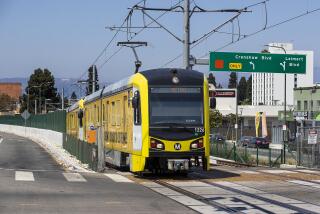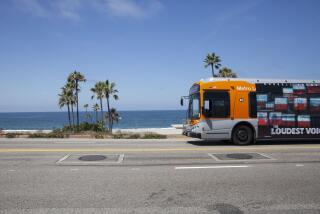Chicago’s Fabled ‘El’ Lines Are 100 Years Old; They’re Still Going Like 60
- Share via
CHICAGO — It all started when 14-year-old Freddie Cann dropped his nickel in the slot on June 6, 1892.
For his five cents, the boy got a 3 1/2-mile run from Congress Street to 39th Street. A small steam locomotive pulled four olive green-and-gilt coaches--paneled inside with oak and cherry--along tracks raised to second-story level.
He was the first paying passenger on the Chicago elevated lines--the fabled “El,” which transported the Second City from the horse-drawn 19th Century to the mechanized motion of the 20th Century.
The cars are steel and plastic now. That first El stop was replaced by a subway station nearly 50 years ago and a nickel won’t even get you a transfer anymore--the fare is now $1.50. But the El still takes Chicagoans to work and play, seven days a week; last year, it carried 139.9 million passengers.
It was not the first American elevated line. In fact, Chicago’s stations and steel supporting structures were identical to those ones used earlier in Manhattan and Brooklyn.
Due to a quirk in local laws, though, the Chicago route followed back alleys, rather than the major streets. That meant Cann and his 13 fellow passengers could look into the back windows of apartments as they rode.
“The passengers saw bits of domestic life usually hidden from the gaze of passing crowds,” noted a newspaper reporter who was along for that first trip.
For his pink ticket on the Chicago & South Side Rapid Transit Railroad Co., Cann also got to witness the first altercation on the El--a squabble between the conductor and two passengers who didn’t want to extinguish their two-for-a-nickel cigars.
“Ain’t you got no smoking car on this train?” asked one of the passengers.
“No, we ain’t, and you don’t want to get fresh, either,” was the conductor’s reply.
The city’s newspapers reported the rudeness. They also ran stories questioning whether the El would ever be profitable, whether it was safe and whether its builders and operators were using good business sense and ethics.
Early passengers were pleased that the one-way trip took only 14 minutes--half the time it would have taken on the street-level cable cars that had replaced horse-drawn street cars around 1880.
Within the year, the line was extended eight miles south to the gates of the World’s Columbian Exposition, Chicago’s first World’s Fair.
The city’s second elevated railroad, the Lake Street line, was built in 1893 by promoter and streetcar magnate Charles Yerkes, who inherited the project from West Side gambling den operator Michael C. McDonald.
In 1897, Yerkes built the Union Loop, which circles the downtown business district--and gave the district its name. And other lines followed.
By 1897, the tracks also had been electrified and were traveled by cars that each had their own electric motor.
In part, the move was a way of getting around early pollution laws, which required clean-burning and expensive anthracite for passenger locomotives. The central powerhouse that provided electricity to the tracks was allowed to burn cheap Illinois soft coal.
Yerkes, who provided inspiration for three of Theodore Dreiser’s novels about a business buccaneer, sold out in 1901 and moved to London, where he set up British rapid transit systems. He once summed up his philosophy by saying: “Buy up old junk, fix it up a little and unload it on other fellows.”
One of the fellows Yerkes eventually unloaded the El system on was British-born Samuel Insull, who dominated the nation’s public utilities during the 1920s through a series of Chicago-based holding companies.
Insull fled to Greece in 1932 to escape impending fraud and embezzlement indictments. He was brought to trial and acquitted in 1935 but lost his business empire.
Under Insull’s regime, more elaborate stations were installed on the original South Side line. Some stations also were fitted with freight elevators for coffins. A special rapid transit car designed for funerals served area cemeteries from 1905 to 1932.
More to Read
Sign up for Essential California
The most important California stories and recommendations in your inbox every morning.
You may occasionally receive promotional content from the Los Angeles Times.













